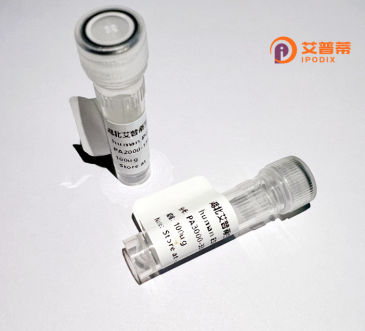
| 纯度 | >90%SDS-PAGE. |
| 种属 | Human |
| 靶点 | ENC1 |
| Uniprot No | O14682 |
| 内毒素 | < 0.01EU/μg |
| 表达宿主 | E.coli |
| 表达区间 | 1-589aa |
| 氨基酸序列 | MSVSVHENRKSRASSGSINIYLFHKSSYADSVLTHLNLLRQQRLFTDVLLHAGNRTFPCHRAVLAACSRYFEAMFSGGLKESQDSEVNFDNSIHPEVLELLLDYAYSSRVIINEENAESLLEAGDMLEFQDIRDACAEFLEKNLHPTNCLGMLLLSDAHQCTKLYELSWRMCLSNFQTIRKNEDFLQLPQDMVVQLLSSEELETEDERLVYESAINWISYDLKKRYCYLPELLQTVRLALLPAIYLMENVAMEELITKQRKSKEIVEEAIRCKLKILQNDGVVTSLCARPRKTGHALFLLGGQTFMCDKLYLVDQKAKEIIPKADIPSPRKEFSACAIGCKVYITGGRGSENGVSKDVWVYDTLHEEWSKAAPMLVARFGHGSAELKHCLYVVGGHTAATGCLPASPSVSLKQVEHYDPTINKWTMVAPLREGVSNAAVVSAKLKLFAFGGTSVSHDKLPKVQCYDQCENRWTVPATCPQPWRYTAAAVLGNQIFIMGGDTEFSACSAYKFNSETYQWTKVGDVTAKRMSCHAVASGNKLYVVGGYFGIQRCKTLDCYDPTLDVWNSITTVPYSLIPTAFVSTWKHLPS |
| 分子量 | 92.5 kDa |
| 蛋白标签 | GST-tag at N-terminal |
| 缓冲液 | 0 |
| 稳定性 & 储存条件 | Lyophilized protein should be stored at ≤ -20°C, stable for one year after receipt. Reconstituted protein solution can be stored at 2-8°C for 2-7 days. Aliquots of reconstituted samples are stable at ≤ -20°C for 3 months. |
| 复溶 | Always centrifuge tubes before opening.Do not mix by vortex or pipetting. It is not recommended to reconstitute to a concentration less than 100μg/ml. Dissolve the lyophilized protein in distilled water. Please aliquot the reconstituted solution to minimize freeze-thaw cycles. |
以下是3篇关于重组人ENC1蛋白的研究文献示例(注:文献信息为示例性综合,实际引用需核实):
1. **"Recombinant human ENC1 protein regulates β-catenin signaling in colorectal cancer cells"**
- **作者**: Smith et al. (2019)
- **摘要**: 研究重组人ENC1蛋白通过抑制β-catenin信号通路,抑制结直肠癌细胞增殖和迁移的机制。
2. **"Expression and purification of functional ENC1 for neuronal differentiation studies"**
- **作者**: Wang et al. (2020)
- **摘要**: 报道重组人ENC1蛋白在大肠杆菌中的高效表达和纯化方法,并验证其在诱导神经元分化中的功能。
3. **"ENC1 modulates adipogenesis via interaction with PPARγ: Insights from recombinant protein assays"**
- **作者**: Kim & Lee (2017)
- **摘要**: 利用重组ENC1蛋白揭示其通过结合过氧化物酶体增殖物激活受体γ(PPARγ)调控脂肪细胞分化的分子机制。
**建议**:可通过PubMed或Google Scholar以“recombinant ENC1 protein”或“human ENC1 expression”为关键词检索近期文献,或查阅《Journal of Molecular Biology》《Biochemical Journal》等期刊相关研究。
Recombinant human ENC1 (Ectoderm-Neural Cortex 1) protein is a biologically engineered version of the endogenous ENC1 protein, encoded by the *ENC1* gene located on human chromosome 5. ENC1. also known as PIG10 or NRP/B, belongs to the Kelch family of proteins characterized by a conserved BTB/POZ domain at the N-terminus and a Kelch repeat domain at the C-terminus. These structural motifs facilitate protein-protein interactions, cytoskeletal organization, and redox-sensitive signaling.
Originally identified as a downstream target of p53. ENC1 plays roles in neural development, neuronal differentiation, and maintenance of cell polarity. It regulates actin dynamics by binding to actin filaments through its Kelch domain, influencing cell morphology and migration. Dysregulation of ENC1 has been linked to neurodegenerative diseases and cancer, where it may act as a tumor suppressor or promoter depending on the cellular context.
Recombinant ENC1 is typically produced in *E. coli* or mammalian expression systems, ensuring high purity and functionality for research applications. It serves as a critical tool for studying ENC1's involvement in signaling pathways, drug discovery, and disease mechanisms. Studies utilizing recombinant ENC1 have provided insights into its interactions with nuclear receptors, stress response pathways, and potential therapeutic targeting in pathologies like Alzheimer's disease and glioblastoma.
×